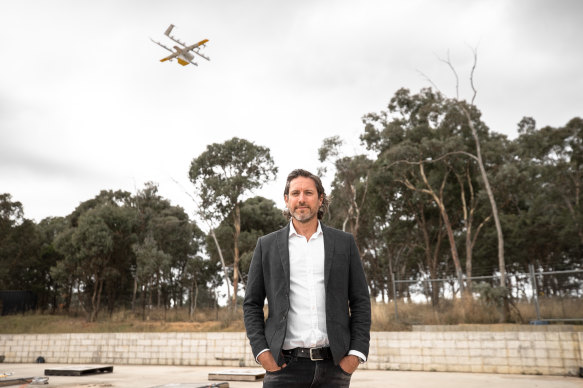
Rather than aiming to replace the postal system or truck deliveries, Wing has positioned itself as a quicker, cheaper, safer and more environmentally friendly way to get small items to nearby customers. And those claims do appear to be backed up by research, albeit commissioned by Wing.
“Most deliveries for those smaller items are currently done by cars or large motorbikes or even trucks. So we’re starting to match up the weight of the parcel with the right delivery vehicle to make that delivery,” Rossi said, adding that retailers establishing infrastructure for click-and-collect could easily include a drone option at the same time.
“We think we can play a role there as well, the smaller parcels a drone can perhaps pick up, saving people the time to go out and have to collect it themselves.”

Wing’s Simon Rossi said people in suburbs around south Queensland have been demanding drone deliveries after seeing them made to their neighbours.
The drone nests need to be positioned where they’ll reach the most consumers but also in a spot convenient for businesses, with Rossi saying the company looked to find underutilised spaces in existing retail environments. For example, one nest is outside a Coles loading bay, and another is on a supermarket roof.
Once an order is received and sent to the business, Wing’s network automatically plots a safe course to the delivery address, and once the package is attached, it flies at about 70 metres above the ground, at about 110 kilometres per hour.
Since the company doesn’t want pickers, supermarket workers or customers anywhere near the spinning propellers of the drones, the machines use a seven-metre retractable cable to collect and drop off packages. If for some reason a customer tries to catch a drone by pulling on the cable, the wire detaches and the drone returns home.
Wing has also recently developed a device called the autoloader, which will allow packages to be hung ahead of time, with drones able to lower the cable and snag the item autonomously.
Customers receiving the item don’t need to have a target on their lawn or interact with the drone at all to get their delivery; they just wait for it to drop the goods outside. For a range of reasons, Wing currently only delivers to single family dwellings, not apartment buildings.
Loading
The drones can currently only deliver to about seven kilometres away from their nest, and then they fly straight back to recharge. But as part of Wing’s recently released product road map, eventually an increasing density of nests will allow more range and efficiency.
“A drone will be able to take off from point A, deliver to point B, then go to point C to recharge, collect from Point D and then to point A to drop off again,” Rossi said.
“So you get this network effect where you not only cover everybody within that seven kilometres, but you can also move your resources around depending on where demand patterns might be at the time. We’re not quite there yet.”
Get news and reviews on technology, gadgets and gaming in our Technology newsletter every Friday. Sign up here.



























